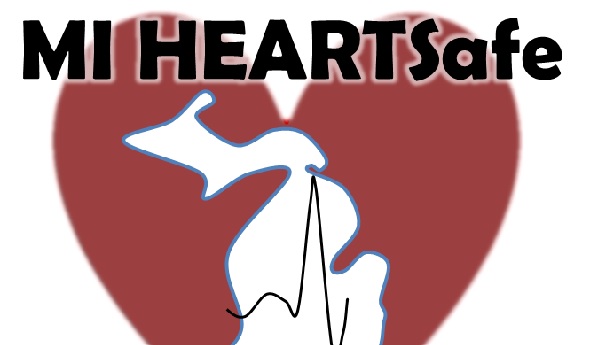
105 Schools Recognized As HEARTSafe
October 19, 2016
The Michigan Departments of Health and Human Services (MDHHS), and Education (MDE); American Heart Association (AHA); Michigan High School Athletic Association (MHSAA); and Michigan Alliance for Prevention of Sudden Cardiac Death of the Young (MAP-SCDY) have awarded 105 schools in Michigan with the MI HEARTSafe School designation which recognizes schools that are prepared to respond to cardiac emergencies.
“Many sudden cardiac deaths that claim the lives of children and young adults could be prevented through screening, detection, and treatment,” said Dr. Eden Wells, chief medical executive of MDHHS. “Appropriate medical response within three to five minutes is crucial for increasing the chance of survival, which is why I’m pleased to see so many of our schools taking vital measures to prepare and address this health issue.”
In order for a school to receive a MI HEARTSafe School designation, it must perform at least one cardiac emergency response drill per year, have a written medical emergency response plan and team, have current CPR/AED certification of at least 10 percent of staff, 100 percent of head varsity coaches, and 50 percent of P.E. staff; have accessible, properly maintained and inspected AEDs with signs identifying their location; and ensure pre-participation sports screening of all student athletes using the current physical and history form endorsed by the Michigan High School Athletic Association.
“We are so proud to support Michigan’s HEARTSafe schools,” said State Superintendent Brian Whiston. “Ensuring schools are prepared for sudden cardiac emergencies through planning, training, and life-saving AEDs is an important part of having safer learning environments for students, staff, and the community.”
Between 2003 and 2012 in Michigan, there were 2,590 young individuals between 1 and 39 years of age who died of sudden cardiac death. Of those, 214 were between 5 and 19 years of age. This is the third year of the MI HEARTSafe Schools program in Michigan. In the first two years of the initiative, 162 schools were previously designated as MI HEARTSafe Schools and prepared to help reduce the number of sudden cardiac deaths in our youth.
Public Act 12 of 2014 requires all schools (grades kindergarten to 12) to have a cardiac emergency response plan in place. This MI HEARTSafe School designation recognizes the 267 school buildings that have taken steps above and beyond to prepare to respond in the event of a cardiac emergency, and is awarded for a period of three years. Click for the list of designated schools.
Schools that meet all of the requirements will be able to apply for the MI HEARTSafe School designation each year. Click for information about the MI HEARTSafe Schools program.

Council Approves Winter Start, Guidance
October 23, 2020
By Geoff Kimmerly
Second Half editor
The Representative Council of the Michigan High School Athletic Association confirmed during its meeting Thursday (Oct. 22) that 2020-21 Winter sports will begin on time, and also approved a series of guidelines for those sports that schools must follow as they continue to work toward limiting the spread of COVID-19 while still providing opportunities for athletes to compete.
Most high school sports traditionally begin practice during the first three weeks of November, with competition starting during mid-November and the first weeks of December. The starts of middle school Winter sports seasons are determined by local leagues and conferences; many are slated to begin during the next few weeks.
Sport-specific guidelines for all Winter sports will be posted early next week to their respective sport pages on the MHSAA Website. A number of precautions have been put in place addressing competition limits, numbers of spectators allowed and wearing of face coverings, among a variety of topics. The guidance also specifically addresses equipment and facilities for each sport.
“The Council believes it is safer to begin Winter practices on time, and keep athletes in school programs where safety precautions are always in effect,” MHSAA Executive Director Mark Uyl said. “With the vastly different circumstances faced by schools in different regions all over the state, an on-time start still allows schools to decide when they feel most comfortable beginning activity – and allows all of them to slowly ramp up their frequency of activity and numbers of spectators attending competitions.
“But let’s be clear: Our statewide COVID-19 numbers have to get better. In order for our schools to continue playing sports this winter, and in order for fans to be there to cheer them on, we must continue working to slow down this virus.”
As with Fall sports, scrimmages will not be allowed for Winter sports to limit mixing of communities outside of official competitions. The numbers of teams at regular-season competitions also will be limited, like during Fall, with a maximum of four schools/teams allowed in competitive cheer, gymnastics, swimming & diving and wrestling. Bowling and skiing competitions will be restricted to a maximum of 72 competitors at one event.
There are no school/team limits for basketball and ice hockey, as only two teams are able to play each other at one time and those sports may play only one game per day – with fans leaving after their game is complete. Host sites must strictly enforce spectator capacity limits on a game-by-game basis. The Council approved as part of these guidelines an allowance of two spectators per participant at all contests to begin the regular season. This guideline could be reconsidered by the Council later in the winter season, with a possibility of allowing more spectators later while still staying within possible Emergency Orders from the Michigan Department of Health and Human Services (MDHHS).
As per MDHHS requirements, face coverings must be worn by athletes practicing and competing in basketball, competitive cheer, ice hockey and wrestling. They are not required for athletes practicing and competing in bowling, gymnastics, skiing and swimming & diving, which all allow for appropriate social distancing – but face coverings are required for those athletes when not involved in active participation.

